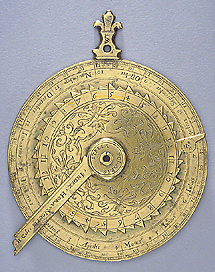
 |
| Catalogue |
 |
 Nocturnal The front of the disc has a circular calendrical scale with the usual Latin names of the months, numbered 1 to 12 starting with January. Each month has the corresponding number of days (December has 311/4 to indicate the leap year), numbered by 10 and divided to 1. The centre of the handle corresponds to 24th October. In the centre of this scale is a volvelle with an hour scale, numbered anticlockwise 1 to 12, 1 to 12. Teeth of alternating size indicate the full and half hours. An index with a sun effigy at 12 o'clock allows this volvelle to be set to the correct date. The centre of the disc is engraved with scrollwork. Over this volvelle rotates an index arm, marked around the central hole 'STELLA POLARIS' and along the arm 'INDEX HORA NOCTIS'. The signature of the maker 'H Cole' is inscribed on the same arm. The reverse is inscribed with several circular scales as follows (from the outside): 1) A degree scale 0? to 360?, numbered by 10? and divided to single degrees. 2) A 24 hour scale, numbered clockwise 1 to 12, 1 to 12. 3) A compass rose of 32 points, with the eight cardinal points shown by their first letter(s), North indicated by a fleur-de-lis. In the centre of this scale is a fixed disc inscribed with the age of the moon 1 to 30. Over this disc rotates a volvelle with an index. A circular aperture shows the phases of the moon. The plate is marked with planetary aspects but has not been completed. The combination of scales 2 and 3 with the central disc and volvelle allow the prediction of high tide at a particular port (provided the direction of this place is known) as described by Digges in his Prognostication, printed by Thomas Gemini in 1555. The instrument was purchased in 1857 and is described and illustrated in R. T. Gunther, "The Great Astrolabe and other Scientific Instruments of Humphrey Cole", Archaeologia, 76 (1927), pp. 273-317, esp. pp. 293 ff.; F. A. B. Ward, A Catalogue of European Scientific Instruments in the Department of Medieval and Later Antiquities of the British Museum (London, 1981), pp. 74 ff. (with plate XXVIII). Silke Ackermann |



